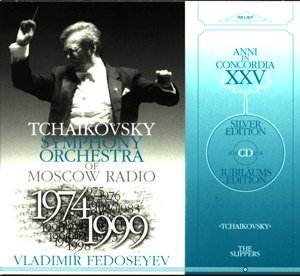Tchaikovsky
was constantly drawn to try his hand at opera, particularly after
seeing Carmen in Paris in 1876 and, later the same year, Wagner
at Bayreuth. Earlier in the decade he had worked on an opera called
Undine (or Ondine) and when it was rejected by St. Petersburg
he destroyed much of it, keeping only some of the best music for
re-use. He certainly re-worked much of what he had kept in ‘Vakula
the Smith’ of 1876, when his foreign experiences had given him
a firmer grasp of the operatic genre. That work was said to contain
well written lyrical love duets and dance music; it was based
on Gogol’s fairy tale ‘The Night before Christmas’. However, it
was recognised as a failure by the ever self-critical composer.
The music remained dear to him and he re-worked the whole as ‘Cherevichki’
(The Little Shoes) and conducted its premiere in Moscow’s Bolshoi
Theatre in December 1886.
In
the opera’s adaptation of Gogol’s fairy tale poem, the witch Solokha
is approached by the amorous devil who flies off to steal the
moon and revenge himself on her son, Vakula, who has made an ugly
painting of him. This hinders Vakula who is making his way to
court Oksana. Oksana’s drunken father and his friend arrive and
are thrown out by Vakula to Oksana’s annoyance. The drunken pair,
and the devil, end up in sacks behind the stove. They are carried
out by Vakula who catches the devil by the tail, and via the sign
of the cross, holds him in his power. Vakula forces the devil
to fly the pair to St. Petersburg to obtain a pair of ‘Cherevichki’
(Royal Slippers) that Oksana has demanded in return for her marriage
to him. There is of course much more to the plot than the foregoing
and the booklet gives a very good synopsis, with occasional track
references, albeit that the English translation is sometimes rather
idiosyncratic.
Listening
to this well cast and sung performance, I couldn’t help regretting
that Tchaikovsky’s genius for melody that infects, and inflects,
his symphonies, concertos and ballets, to a great extent eluded
him in his operatic works. For much of the time the music is simply
supporting the singers acting out their part in the fairy tale.
The music does not convey the story, or the evolution of the characters,
in the way contemporaneous works by Verdi and Wagner, for example,
do, although, as mentioned, there is good invention in the dance
music and love songs. Given the above, it is vital to sustain
interest so that the singers can convey the story, via their vocal
skills, and carry the drama forward. In these respects this recording
is very fortunate in both its principal singers and those in the
comprimario parts. The young lovers, Oksana and Vakula are outstanding.
Nina Formina, as Oksana, has a pure lyric voice with good extension
at both ends of its range, allied to good vocal colour, expression
and elegant phrasing. These facets are the perfect recipe for
conveying the varying demands of the part from melancholy (CD1
tr.4), to the teasing of Vacula (CD 1 trs. 7-8). As her suitor
Vakula, Konstantin Lissovsky has a virile, clear, open-toned,
lyric tenor voice. He exhibits good phrasing and a varied range
of expression as exemplified by his reproaching of Oksana (CD2
tr.3). He also impresses in the scene where he takes the devil
by the tail in the first scene of Act 3 (CD2 tr.7). As the devil
the baritone Oleg Klenov (1932-1997) is most impressive. His excellent
diction, powerful expressive voice and wide palette of colour
and range combine to give a convincing and involving portrayal.
CD 1 trs.2-3 conveys a sample of his fine dramatic and vocal skills.
Lyudmilla Simonova as the witch is shown as a soprano. For my
money she is a dramatic mezzo, try CD1 trs.2 and 10. However,
denoted register matters little when pitted against her characterisation
of a very demanding role that, above all, must not be bland if
the drama and moods of the opera are to be conveyed. In this latter
respect, as in the other works in this series, the chorus and
orchestra have vital parts to play. Whilst the chorus play a fulsome
part, CD 2 tr. 2 and elsewhere, and the orchestra is vibrant in
the dance music, there are times when I wished the conductor would
vary the dynamics more. The orchestra can sound relentless and
lacking in rhythmic vitality. Or is that lack more Tchaikovsky’s
than that of the conductor? Mea culpa for I have no comparison.
The
analogue recording is clear and open with excellent dynamic range.
In my review of Rimsky’s ‘May Night’, in this series (elsewhere
on this site) I set out detailed criticisms of the layout and
presentation of information in the booklet and on the inner face
of the folding slipcase. Much the same criticisms apply here with
the libretto given in Cyrillic script Russian broken only by track
numbers, these having a very brief description in English and
Act indications. However, as mentioned, the synopsis is good and
the artist profiles are in English and German.
Whilst
this little known work does not draw the best of uniform melodic
invention from Tchaikovsky, this performance is convincing. It
is as good as we are likely to get on record. It is a very welcome
addition to an all too slow expansion, in the catalogue, of Russian
operatic works readily available outside that country. I commend
it to all those interested in the genre and the composer’s works.
Robert
J Farr
